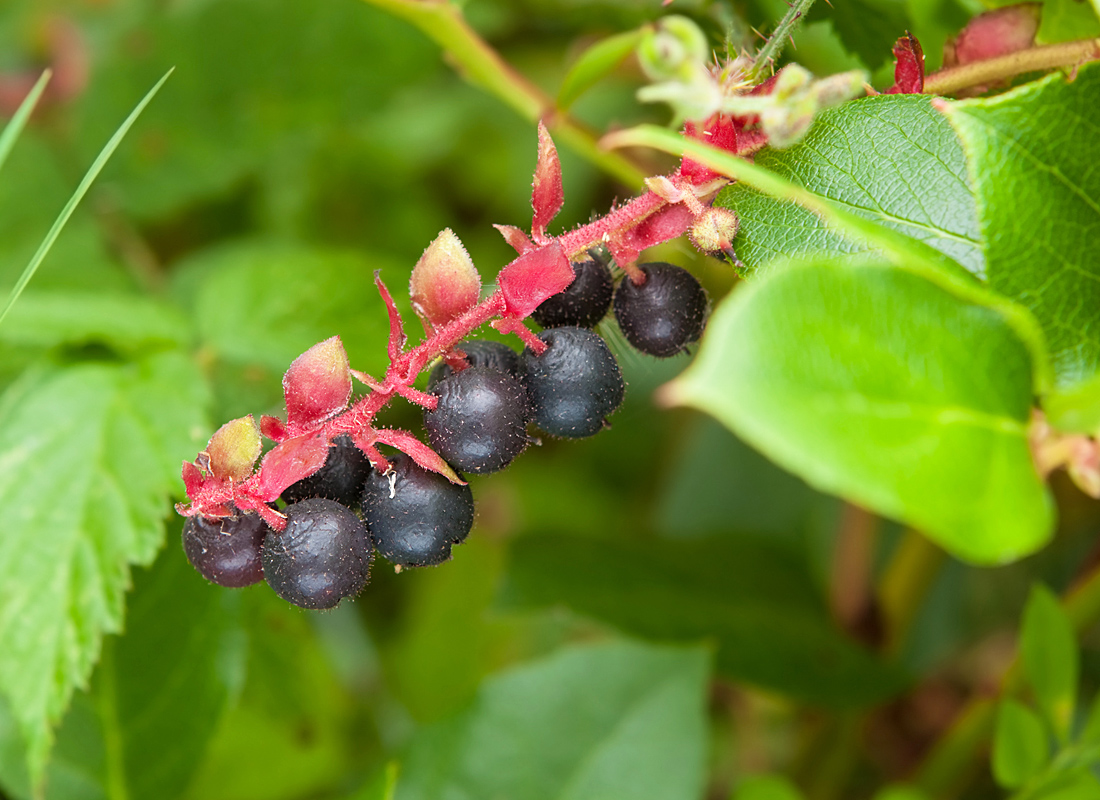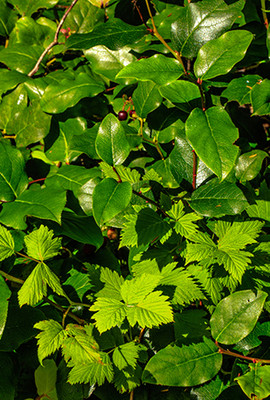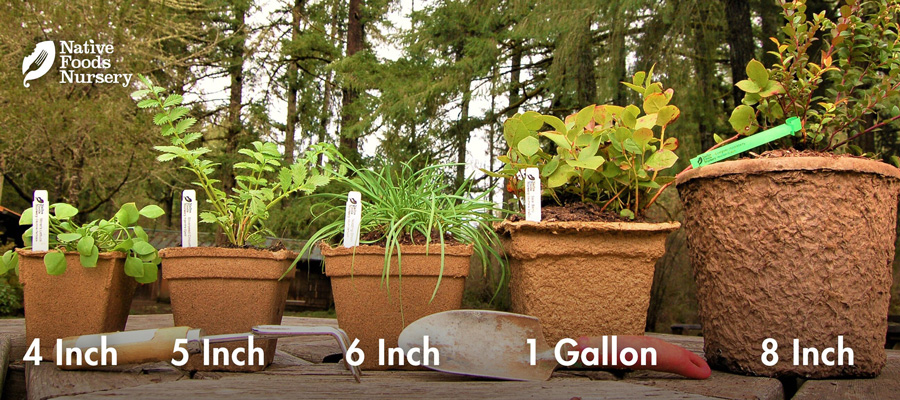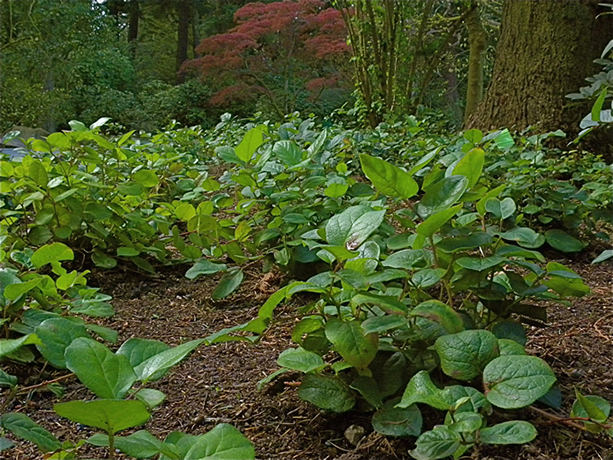Salal Berry
- Current Stock:
- 0
- Other Names:
- Evergreen Blueberry, Wintergreen, Shallon, sxelálen (Straits Salish, pronounced “skhuh-LAH-len”)
- Latin Name:
- Gaultheria Shallon
Salal is one of the Pacific Northwest’s most iconic understory evergreens—its glossy leaves, pink-white spring blossoms, and dusky blue fruits bring year-round life and flavor to the forest edge.
Edible Uses
The dark berries are sweet with a rich, winey flavor and can be eaten fresh, made into jams, or mashed and dried into fruit “cakes” for long storage [1]. Their high polyphenol and anthocyanin content gives them both deep color and notable antioxidant value [2]. The young leaves were also sometimes brewed as a mild tea [3].
Ornamental Qualities
Salal is prized as a lush evergreen groundcover and cut-foliage plant, widely used in floral arrangements [4]. Its compact habit and tolerance for shade make it ideal beneath other trees such as Pacific Crab Apple, Oregon White Oak, or even our native pine nuts. The urn-shaped flowers bloom in spring and give way to dark berries that contrast beautifully with leathery foliage.
Environment and Culture
Ecology: A keystone shrub of the coastal temperate rainforest, Salal grows from northern California to Alaska in conifer understories, forest edges, and coastal dunes [5]. It stabilizes soil, shelters small wildlife, and provides nectar for native bees and hummingbirds [6].
Culture: Salal is honored as a First Food among Coast Salish, Nuu-chah-nulth, and other Northwest peoples, who continue to harvest and tend it as both nourishment and teacher [7]. The English name “salal” comes directly from sx̣əlálen in SENĆOŦEN. We honor their enduring relationship with this plant and invite support for Indigenous-led restoration (see our Charitable Giving page).
Harvest, Care, and Preparation
Once established, Salal needs little care beyond light summer watering in its first year. It thrives in acidic, well-drained soils and partial shade. Harvest berries when they turn deep purple and soft to the touch (late summer–early fall).
→ For detailed guidance, see the Planting Guide tab.
Attributes
- Native Range: CA, OR, WA, BC [1]
- USDA Zones: 5–10 [1]
- Ease of Care: Easy
- Deer Resistance: Moderate–High [4]
- Light Requirements: Shade to full sun; more shade in southern climates, more sun in northern [1][5]
- Soil Type: Acidic, well-drained, humus-rich [5]
- Water Requirements: Moist to moderately dry; drought-tolerant once established [5]
- Pollination: Self-fertile
- Bearing Age: 2–3 years
- Size at Maturity: 1–6 ft tall, spreading 3–8 ft [4]
- Bloom Time: May–June
- Harvest Time: August–October
- Indigenous Names: sx̣əlálen (SENĆOŦEN — “skhuh-LAH-len”), sxʷəláɬən (Hul’q’umi’num’ — “skhwuh-LAH-thun”), šʔaʔił (Nuu-chah-nulth — “SHAH-eelth”) [7]
References
[1] USDA PLANTS Database, Gaultheria shallon.
[2] Hummer, C., “Phenolics and Antioxidant Capacity in Gaultheria shallon,” J. Food Comp. Anal., 2010.
[3] Turner, N. J., Food Plants of Coastal First Peoples, 1995.
[4] Oregon State University, Landscape Plants: Gaultheria shallon.
[5] Pojar, J. & MacKinnon, A., Plants of the Pacific Northwest Coast, 2014.
[6] USFS Plant Guide, Gaultheria shallon.
[7] Moerman, D., Native American Ethnobotany, 1998.
Pot Sizing Guide
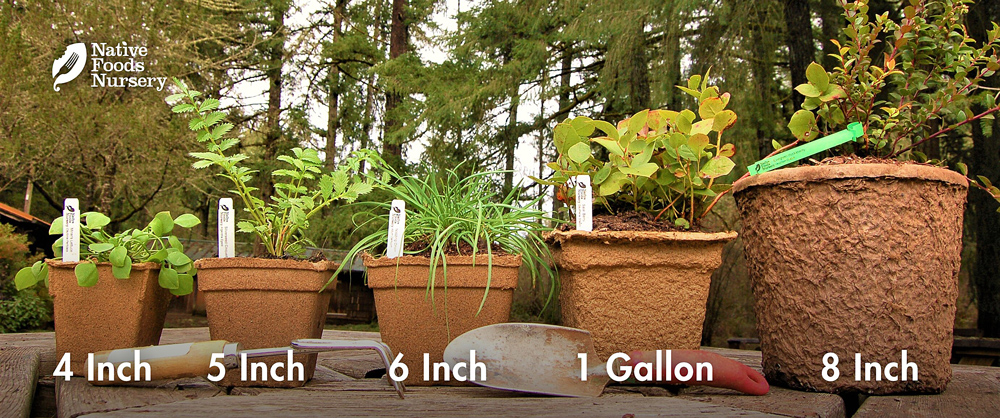
Permaculture Tip: Think “forest edge.” Salal thrives at the boundary of light and shade—along paths, under tall conifers, or on north and east slopes where duff collects. Mimic these natural conditions for effortless success.
Choosing a Site
Light: Partial shade to full shade in southern or inland sites; part to full sun along the coast or in cooler northern zones.
Soil: Prefers well-drained, acidic, humus-rich soil similar to a forest floor. Amend heavy or alkaline soils with composted bark, leaf mold, or peat substitute.
Space: Plant 2–3 ft apart for a dense groundcover, or 4–6 ft apart for more open, natural groupings. Allow room for spreading rhizomes.
Planting Steps
Plant in fall (best) or early spring while soil is cool and moist. Dig a hole twice the root ball’s width but no deeper. Loosen soil along the sides and mix in organic matter. Set the plant so the top of the root ball is level with surrounding soil. Backfill gently, water deeply to settle, and apply 2–3 inches of coarse mulch—keeping mulch a few inches away from stems.
Watering & Establishment
Year 1–2: Keep evenly moist but not waterlogged. Deep soak every 7–10 days during dry spells. Avoid constant light watering.
After Establishment: Once roots are deep and soil is shaded by foliage, salal is remarkably drought-tolerant, especially in coastal climates. Occasional summer watering during long droughts will boost fruiting and density.
Care & Maintenance
Pruning: Lightly prune after fruiting or in late winter to encourage fresh, vigorous shoots. Cut back woody or leggy stems to the base to rejuvenate older stands.
Mulching: Refresh mulch yearly with conifer duff, pine needles, or fine bark to maintain acidity and moisture.
Feeding: Usually unnecessary; if growth is weak, apply a thin layer of compost in early spring.
Propagation
Salal spreads slowly by rhizomes and can also be propagated by semi-ripe cuttings taken in late summer. Root cuttings in a well-drained peat/sand mix under light shade and high humidity. Once rooted, overwinter in pots and transplant the following spring.
Harvest & Use
Fruits ripen from late summer through early fall, turning dark blue-black and slightly soft to the touch. Harvest by hand or gently rake clusters into a basket. The berries are excellent fresh, dried into fruit leather, or made into preserves and syrups. Leaves can be used decoratively or brewed as a mild tea.
Ecological Notes
Salal forms dense mats that protect soil and provide nesting habitat for birds and small mammals. It’s a critical understory species supporting native pollinators, especially bumblebees and hummingbirds drawn to its bell-shaped flowers in spring.
